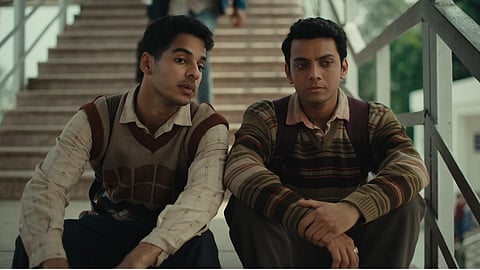

Follow TNM's WhatsApp channel for news updates and story links.
When the COVID-19 pandemic ravaged the world, humans were reduced to cases, numbers, and data. In a country that has vastly manipulated its data, several lives were not even accounted for, as if they never existed.
What happens when you zoom in, and take a slice of two men's lives? It might show their inherent humanness, and the lives that often get lost in the larger narrative of disaster. It might even shatter you. That is precisely what filmmaker Neeraj Ghaywan does with Homebound.
Homebound is based on The New York Times story by Indian journalist Basharat Peer, which stemmed from an image taken in a mobile phone of two migrant workers making their way home as part of the mass migration during the pandemic. It is from this single, haunting snapshot, as well as Basharat’s story, that Ghaywan builds a narrative that explores much more than the pandemic.
Homebound is a masterclass in weaving caste, religion, systemic disparities, gender politics, and the intersectionality of it all into a heart-shattering story of two close friends who are forced to become migrant labourers because of the State’s refusal to acknowledge their existence.
At the heart of Homebound lies the question of identity. Set in rural Uttar Pradesh, a state infamous for its violence against Muslims and Dalits, Homebound zooms in on two men: a Dalit and a Muslim. The film then takes us to Surat in Gujarat, the home state of Indian Prime Minister Narendra Modi and the strongest centre of Hindutva nationalism.
Mohammed Shoaib Ali (played by Ishaan Khatter) and Chandan Kumar (Vishal Jethwa) are trapped not only by a pandemic, but by the very system that refuses to acknowledge their existence. The two childhood friends aspire to land a job in the police department – a government job will give them ijjat and paisa (dignity and money) – but are forced into migrant labour to support their families.
Through their eyes, we see the layers of caste and religion, as well as an intersecting layer of gender. The migrant labour crisis, which shocked the world during the pandemic, forms the backdrop of this story.
Homebound skillfully addresses a number of intersecting questions: How do you show that possessing a Hindu identity offers you a layer of protection, until people start asking for your caste surname? How can you depict the confusion over embracing one’s identity but holding space for powerlessness? How can the further discrimination that women face within the caste system be presented? And how do you weave in the layer of economic empowerment?
The film’s power is inseparable from its performances. Ishaan Khatter embodies the quiet vulnerability and endurance of a Muslim man caught in a hostile world, and Vishal Jethwa matches him beat for beat, bringing raw intensity and fragility to Chandan. Despite her limited screen time, Janhvi Kapoor (as Sudha Bharti) leaves behind an imprint of quiet resilience. The supporting cast, too, shines: Shalini Vatsa’s role as Phool is devastating in its heartbreak, while Harshika Parmar’s Vaishali, though brief, resonates with us, as a young woman forced to sacrifice her dreams for the sake of her brother. The actors playing the parents of both Shoaib and Chandan bring understated but powerful performances that give depth to the film’s exploration of inherited struggles.
There are multiple ways to make a film about marginalised lives. There are films that show the fighting spirit of the people; ones that show the importance of education; others that are just about resistance; and some about survival. There are also films, like Homebound, that show life as it is, a slice of reality, in which people are aware and helpless but also hopeful and forward-looking. One step at a time. Such films remind us that survival is, in itself, an act of defiance.